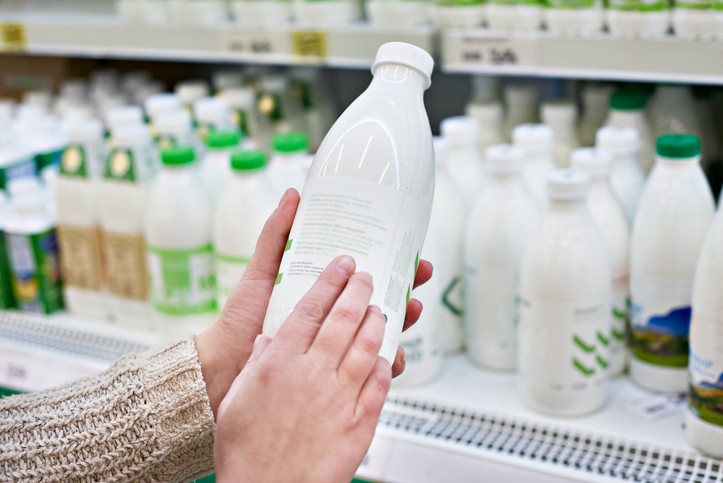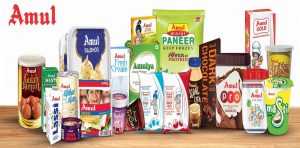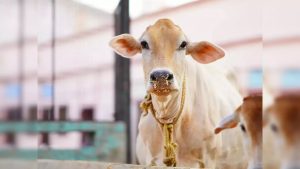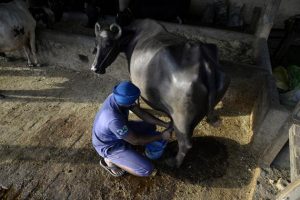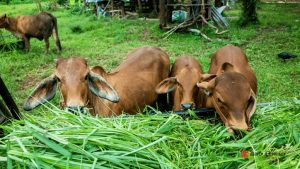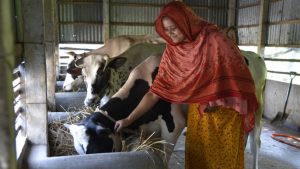This jump in production also saw India become the largest producer of milk, with approximately 192 million tonne produced in 2019. The FAO also projects milk production to grow 1.6%p.a. to 997 million tonne by 2029.
Per capita milk consumption, expressed in the form of dairy solids kg per capita per year is given below:
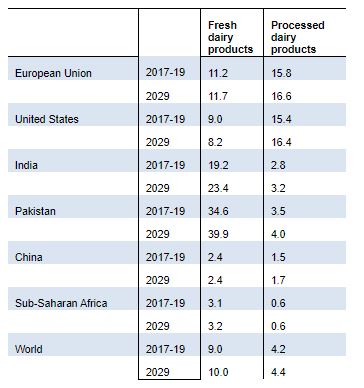
Source: OECD/FAO (2020), “OECD-FAO Agricultural Outlook”, OECD Agriculture statistics (database), http://dx.doi.org/10.1787/agr-outl-data-en.
A few stark differences are visible from the table above. In the Western market there is little growth, and even long-term declines as in the case of processed dairy in EU and fresh dairy in the US. China too shows very little demand for dairy products. On the other hand, Pakistan and India have very high per capita consumption which is also growing both for fresh and processed dairy.
GHG footprint
Fluid milk and mildly processed fresh dairy products are not largely traded across countries. This points to the exacerbation of a problem that has dogged the dairy industry for many years, viz carbon footprint. The average global emissions from milk production are 2.4kg CO2eq per Kg of FPCM (fat and protein corrected milk). This is highest in the developing regions of Africa and south Asia where it can go up to 7.5kgCO2eq per KG of FPCM. In the EU and US, this is at the lower range going right down to 1.3kgCO2per Kg FPCM. Especially in the areas where the carbon footprint is high, the yields are low and not expected to go up dramatically. The FAO again calculates herds to grow by 0.8% p.a. but average yields going up only 0.7% p.a.
This combined with animal welfare concerns have led to the development of a market for dairy alternatives. Paradoxically, the dairy alternative market is growing much faster in the West where the contribution to the issue of GHG emissions is minimal.
Dairy alternatives
Milk, cheese, ice cream, frozen dessert, yogurt, butter, creamer, whipping creams are all available in dairy alternative forms. In 2018, the global dairy alternatives market was estimated to be approximately US$16 bio, compared to US$600+ bio for dairy. We estimated that approximately 22% of the global protein ingredients (>50% protein content ingredients) market was dairy. The author in his personal experience has seen that this % split has not changed dramatically over the past decade.
Hence, while dairy is not facing an existential threat, the growth prospects of dairy especially in the West are challenged quite strongly. This competition will force dairy industry to relook into some processes that may be causing the consumers a lot of concern – environmental footprint, animal welfare, nutritional content that is to say fat content are the main concerns on top of the consumers’ mind. Contamination is another issue with hormones, pesticides and other residues that may have been accumulated in the milk through the environment.
Covid-19 impact
One of the key trends to consider in the current scenario, and something which is very tough immediately to understand – how are consumers reacting to the pandemic. What changes in consumption patterns are becoming important and obvious. What nonobvious changes will impact the consumption patterns in the future?
We have split the Covid-19 Impact by Three Phase Model Analysis (Pre-Covid, Covid & Post-Covid). We already know what was happening before the pandemic struck and many of our forecasts are based on the understanding of how markets have evolved over the past century.
Some of the trends that we have observed from the market are given below:
• End-users trying to streamline ingredients lists with common raw material sourcing, e.g. pea protein and pea fibre
• Consumer sentiment turning towards healthier analogs whether dairy or meat or egg. The Covid-19 effect is likely to fortify this trend. I talk about this further down.
• The already strong plant protein trend has been enhanced by the perceived holistic wellness associated with many plant-based protein products
• Sales of natural immunity + doing better (immune building + healthy) were good for superfood-based beverage mixes
• Since the consumption of dairy, especially traditional cheeses seems to have taken a hit in France, prompting the dairy interbranch association (CNIEL) to launch a campaign to encourage the consumption of traditional cheeses, will this open the market opportunities for dairy alternatives?
Technical challenges in dairy alternatives
Whenever an alternative is developed for any existing food, be it milk or meat, the challenge is to match the organoleptic, technical, and nutritional functions first. The next challenge would be to exceed these functionalities to create a superior product that will have greater acceptance in the market. Let me first take an example of a product that has exceeded the minimum requirements, historically. The Middle Eastern version of an almond milk – This is given to feverish people as a food and takes the place of medicine. Take sweet, peeled almonds and pound them fine. [Add some water.] Then extract their liquid with a sieve or clean cloth, until it becomes like milk [almond milk]. If the stomach is weak, add rosewater mixed with camphor (Kitab al tabikh (A Middle Eastern recipe compendium), 1226). What this recipe talks about is an almond milk (white liquid) which can be used to cure fevers, hence almost a medicine. Almond milks today are excellent dairy alternatives, and in medieval times seems to have been explored for therapeutic effects. In a survey conducted by us in 2020, almond was the top contender for preferred raw material for dairy free yogurts!
Matching the organoleptic properties of milk is a challenge for dairy alternatives. Earlier it used to be the nutty note of soybeans in the soy milk. This has largely been addressed over the past decade. Currently, the most popular raw material is pea and derivatives of this may have a cooked flavour note, which needs to be overcome. Rice has a gritty note. Chickpea, fava, and lentils are protein sources that have yet to be explored fully for creating acceptable dairy alternatives. Tigernut, spelt buckwheat, sunflower, kamut are also niche sources which may yield acceptable dairy alternatives. Dairy alternative milks have come a long way in terms of taste, mouthfeel, and frothing/foaming abilities, but not completely.
Second-most important factor is the nutritional content. Nutritional profile of dairy alternatives covers a variety of ingredients – protein, minerals, and vitamins. Additionally, presence of antinutritional factors if ever, need to be addressed. A Harvard medical advisory, states – “The quality of plant-based milks varies greatly when it comes to nutrients. Some contain virtually the same amount of vitamins and minerals as cow’s milk; others fall far short. For example, many almond milks are much lower in protein than cow’s milk. If you are going to switch to a plant-based milk, be certain to read the label and find a product that contains good amounts of protein, vitamin D, iron, and calcium. Ideally, aim for a milk that has at least 8 or 9 gram of protein per serving”.
Protein content is one of the comparisons being made. There are other factors that need to be considered for nutritional similarity to milk. Right now, the focus seems to be on creating a consumer acceptable dairy alternative that may or may not match milk in all characteristics. As the market evolves, depending on consumer trends at that time, the formulation of dairy alternatives is expected to vary based on mineral and vitamin content.
Soy is the mainstay of the dairy alternative product range because there is no comparable protein except soy currently in terms of volume supply, product diversity, R&D/NPD already done and nutritional profile. Other raw materials which are being explored will face one or more of the above as challenges.
Cultural background
Dairy is a cultural heritage for many societies. Hence difficult to completely replace. The main reasons to opt for a dairy alternative would be –
• sustainability/animal welfare based, i.e., based on mindset
• Allergies and incompatibilities, i.e., based on physiology
The first reason is under the control of various agencies including civil society, governments, companies to influence either towards or against dairy alternatives. The second reason is a function of nature and should be responded to on an individual basis.
For example, in Europe, dairy is a traditional component of the diet for many centuries and the population will not be weaned off of dairy easily. In the US, while a strong association between dairy and health exists, alternatives are easier adopted by flexitarians. Flexitarians drive the uptake of many of the new foods being developed. India, on the other hand, has an abundance of dairy currently. And with many millennia of association with dairy and dairy products, it would be very difficult to convince consumers to replace dairy with alternatives.
In conclusion
One of the interesting aspects that could be explored for the benefit of both dairy and dairy alternatives are hybrid products. This is like meat extension with the use of texturised proteins. A hybrid can serve many purposes:
• To reduce the carbon footprint of milk
• To reduce the overall impact of lactose intolerance but with many of the good qualities of milk
• To reduce demand-supply gap
• To reduce cost
We are of the opinion that NPD/R&D in the dairy alternative space has to keep in mind the local sensitivities of the geographies to which the dairy alternatives are destined.
(The author is project manager, Giract)

